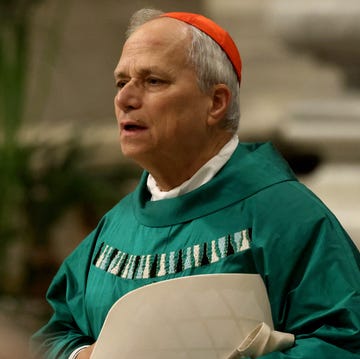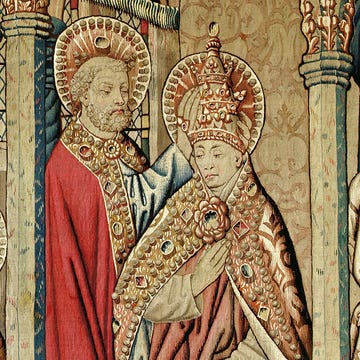Pope Francis and Pope Emeritus Benedict XVI were brothers in Christ before being selected for the most holy position within the Roman Catholic Church. Both men decided early in life to devote themselves to their religion, were ordained, and rose through the Catholic Church’s ranks to become cardinals. Along the way, each gained distinct reputations for how they lived and interpreted their faith.
Despite their different approaches, both men were reportedly considered to replace Pope John Paul II following his April 2005 death. Ultimately, it was Cardinal Joseph Ratzinger of Germany who rose to the papacy as Benedict XVI. Francis, then known as Cardinal Jorge Bergoglio, reportedly had little interest in the papacy then, preferring instead to continue his ongoing work in Argentina.
Their lives intertwined further when Benedict stepped down from the papacy in 2013 and Francis ascended to the role. It marked the first time in more than half a millennia two popes had been alive at the same time.
For Francis, unlike generations of popes before him, that meant his predecessor still resided at close quarters within the Vatican. Their disagreement on many issues pertaining to the Church resulted in a reported split within the organization, with hard-line conservative cardinals and priests aligning with Benedict and progressives leaning into Francis’ more tolerant and inclusive views. As Diarmaid MacCulloch, today an emeritus professor of church history at the University of Oxford, told Vanity Fair in 2018, “two popes is a recipe for schism.”
Benedict reinforced traditional Church practices
Benedict was known for his rigid views on Catholicism long before becoming pope at age 77. Ordained as a priest in 1951 in his native Germany, Benedict went on to become a highly regarded theologian, knowledgeable in the intricacies and fundamentals of his faith. Originally a liberal theologian, his views narrowed over time, and much of his prolific writing concerned upholding the traditional Catholic doctrine.
Described in the media as “the pope of aesthetics,” Benedict reinstated much of the pomp eschewed in the years following the adoption of Vatican II, which did away with many of the visual excesses of the Church. Following his appointment, as the world grappled with a struggling economy, Benedict donned fur-lined vestments, gem-encrusted rings, and pectoral crosses. He also reintroduced the bright red shoes favored by popes long dead.
As the Church reeled in the face of its widespread sex abuse scandal and struggled to find its place in the increasingly secularized 21st century, Benedict saw such visual excess and adherence to doctrine as a way of signaling a return to and reinforcement of the traditional practices and views of Catholicism. Prayer and work remained uppermost, but Benedict still saw strength and unity in the outward, physical expressions of his faith. “All the great works of art, the cathedrals—the Gothic cathedrals and the splendid Baroque churches—are a luminous sign of God, and thus are truly a manifestation, an epiphany of God,” Benedict once said.
In February 2013, at age 85, Benedict became the first pope since Gregory XII in 1415 to resign from the position, due to his age as well as his waning physical and mental stamina. Vowing to stay “hidden from the world” in his new life, Benedict anointed himself with the title pope emeritus. Many faithful to him saw the moniker as a signal he wouldn’t remain as tight-lipped on Church matters as he vowed.
When Francis took over, the Vatican became more minimalistic and modern
Francis, who graduated technical school before being ordained as a priest in 1969, was noted for his humility and focus on mercy. He championed the marginalized and poor of the world. Perhaps another reason the Argentine priest stood out to succeed Benedict was his ability to weather challenges. Francis had been accused of a complicit silence as Argentina’s military dictatorship, in power from 1976 to 1983, carried out murders and abductions while enjoying the backing of the Church.
“As archbishop, he faced a monumental task, and he was even accused of collaboration with the ‘dirty war,’ which he strenuously denied and was ultimately cleared,” Ramon Luzarraga, then the theologian-in-residence at the University of Dayton, told The Guardian in 2013. “If he can restore the credibility of the Church [in Argentina], he can handle the scandals that have befallen the Church worldwide because he knows how to connect to people.”
In March 2013, 76-year-old Francis became the first pope from Latin America. Diverging from Benedict’s style, Francis immediately adopted a less showy, more humble outward appearance. He vowed to continue to live simply, as he had done throughout his career in the Church.
Francis’ vision of Catholicism embraced change and promoted a Church for modern people in modern times, a stark contrast to Benedict’s advocacy for strict adherence to tradition and doctrine. The two views—and the rare occurrence of two living popes—reportedly fueled a factional split within the Vatican.
In 2019, Benedict wrote a letter publicly undercutting Francis
During his successor’s early years as pope, Benedict stepped back from the spotlight, favoring a life of prayer and contemplation in the newly refurbished monastery he moved to within the Vatican. Yet his existence encouraged conservative voices within the Church, who saw Francis’ liberalism as damaging to the Church, particularly in relation to his views on divorce, same-sex marriage, and clerical sexual abuse.
While rare, the physical meetings appeared cordial. But concerns of a simmering rivalry peaked when Benedict broke his silence in April 2019. Although officially in retirement, he penned a 6,000-word letter putting the blame for the Catholic Church’s ongoing clerical sex abuse crisis on a permissive culture stemming from the 1960s, progressive theological ideas, and the disappearance of God from public discourse in the West.
The letter publicly undercut Francis, whose views on the subject had already been made public. The reigning pope laid the blame for the sex abuse crisis directly on the Church, citing a systemic abuse of power and the pursuit of prominence and authority within the existing Church hierarchy.
The letter and resulting aftershocks supported claims that Benedict still retained vast influence within the Vatican hierarchy and among global worshippers. Concern rose that having two living popes, with contradictory stances on important issues, would lead to confusion among the flock. The two men’s all but unprecedented relationship was explored in the 2019 movie The Two Popes, starring Anthony Hopkins as Benedict and Jonathan Pryce as Francis.
Despite tension between the popes, Benedict believed in the power of unity
In the fallout from Benedict’s missive, the Vatican called for unity. In a rare interview granted in the months following the very public split, Benedict told Italian magazine Corriere Della Sera that there is currently only one pope: Francis. He didn’t directly address the reported divergence between himself and his successor, but Benedict made it clear that no matter what happened then or in the future, the Catholic Church would endure.
“The unity of the Church has always been in danger, for centuries,” Benedict was quoted as saying. “It has been for all its history. Wars, internal conflicts, centrifugal forces, threats of schisms… In the end, the awareness that the Church is and must remain united has always prevailed. Its unity has always been stronger than internal struggles and wars.”
Benedict died in December 2022, and after 12 years as pontiff, Francis passed away Monday. Soon, a papal conclave will convene to select a new pope. Time will tell where that man’s priorities and views of Catholicism land on the spectrum outlined by Francis and Benedict and how he will lead the Church forward.
















